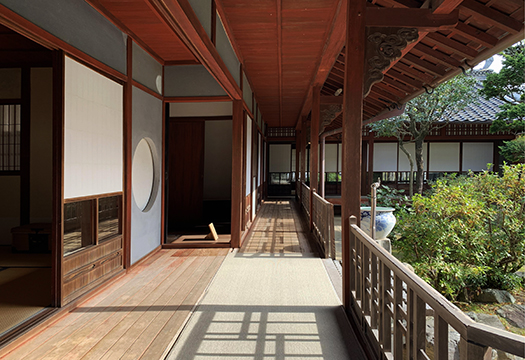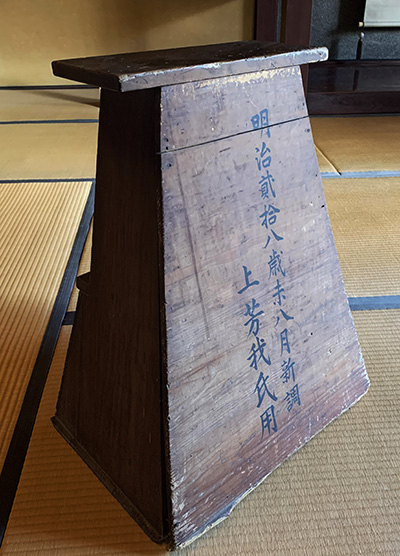

長く続けてしまった四国愛媛・内子の上芳我家住宅探訪記、最終回です。
写真は上芳我家の離れの縁空間と座敷空間の様子。
中庭との関係性・調和が主旋律を構成している様子がわかる。
床の間が付いていることで「格調」が高まり庭の風情がその家の
主人の精神情緒を表現するといういかにもの「もてなし」空間。
そして庭園の樹種選定、その展開構成を「愛でる」空間。
加えて床の間の掛け軸、額装された和風表現群が調和をもたらす。
同じ四国の臥梁山荘や掬月亭などを見て来たけれど、
四国にはこういう和風文化を最上と考える和のインテリアが根強い。
気候風土的に日本列島の中でも、そういう空間構成が最適であるのか。
いかにも「温暖地」という風土性が根付いている。
こういうのはどうも四国の立地性も関係しているのだろうか。
臥梁山荘や掬月亭のなどある時期の中央京都文化をそっくり迎え入れている。
オリジナリティというよりも「桂離宮で」とか「清水の舞台」のようにとか、
その時代の建築文化を端正に移植しているように思える。
わたしどもの北海道の住宅建築ではいちばん最初に破綻したような
和のディテールへの忠実な再現性が重視され、また完成度高く移植されている。
北海道ではこういった和のディテールは早々に気候合理性がないと判断され、
最初期に北海道の住建築を領導した開拓使・黒田清隆などは、
欧米住宅を見学し、見よう見まねで日本の寒冷地住宅に悪戦苦闘していった。
コピーすべきマザーの日本建築に寒冷地対応技術がなかったことで、
建築様式スタイルも、結局オリジナルなものを合理主義で切り開いていった。
そういう意味ではるかな相違を強く感じるのだけれど、
しかし逆にまた、文化は縁辺地域にこそ純粋に残るとも言われるので、
こういう和風という強い実感を得ることになるのではないか。
京都・東京など権力中心のような押しつけの強い住文化とは違って
本質的な和風住文化、日本人の肌合いに似合う部分を感じさせられる。
西洋のルネッサンスが目指したのと似た古き良き住空間マザーという感覚。



そういう和風インテリアのプレーヤーたちも似合っている。
和箪笥は和服衣装の収納装置であるという側面から
現代生活様式の洋風衣装との親和性が薄く、希少化してきた。
しかし主要なインテリア美的空間性で見返すと、その奥行きが深い。
機能性・デザイン性とも日本文化のひとつの極点だろう。
いかにも「花嫁道具」という日本美を体現する装置。
また、掛け軸や額装書画も典型的な日本人的感受性装置。
中国人的な書と絵画性の融合ぶり。
そして最後の写真は踏み台だけれど、職人さんたちの手づくりぶりが
いかにも底光りするように薫っている。・・・
English version⬇
[Japanese interior space, Kamiyoshiga family ⑧ Shikoku living space-46]
A reasonable distance from the center of Japanese culture preserved the good living culture. Is it a Renaissance mother that high heat insulation and high airtightness should aim for?・ ・ ・
This is the final episode of the Shikoku Ehime / Uchiko Kamihoga family housing exploration report that has continued for a long time.
The photo shows the remote edge space and tatami room of the Kamiyoshiga family.
You can see how the relationship and harmony with the courtyard constitutes the main tune.
The alcove enhances the “dignity” of the house and gives it a garden feel.
A “hospitality” space that expresses the spiritual emotions of the master.
And a space where you can “love” the selection of tree species in the garden and its development composition.
In addition, hanging scrolls between the floors and framed Japanese-style expressions bring harmony.
I’ve seen Wo Liang Sanso and Kikugetsutei in the same Shikoku, but
Shikoku has a deep-rooted Japanese interior that considers this kind of Japanese culture to be the best.
Is such a spatial composition optimal even in the Japanese archipelago in terms of climate?
The climate of “warm areas” has taken root.
Is this related to the location of Shikoku?
It welcomes the central Kyoto culture of a certain period, such as Wo Liang Sanso and Kikugetsutei.
Rather than originality, like “at Katsura Imperial Villa” or “The Stage of Kiyomizu”
It seems to be a neat port of the architectural culture of that era.
It seems to be the first to collapse in our Hokkaido residential construction
Faithful reproducibility to Japanese details is emphasized, and it has been transplanted with a high degree of perfection.
In Hokkaido, these Japanese details were quickly judged to be irrelevant to the climate.
Kiyotaka Kuroda, a pioneer who led the residential architecture of Hokkaido in the earliest period,
I visited Western houses and struggled with Japanese cold-weather houses by imitating them.
Because there was no technology for cold regions in the Japanese architecture of the mother to be copied,
As for the architectural style, after all, the original one was opened up by rationalism.
In that sense, I strongly feel a far difference, but
But on the contrary, it is said that culture remains purely in the marginal areas, so
I think you will get a strong sense of Japanese style like this.
Unlike Kyoto, Tokyo, and other intrusive living cultures such as those centered on power
You can feel the essential Japanese-style living culture and the part that suits the texture of Japanese people.
A feeling of a good old living space mother similar to what the Western Renaissance aimed for.
Players with such Japanese interiors look good too.
From the aspect that the Japanese chest is a storage device for Japanese clothes
It has become rare because it has little affinity with Western-style costumes of modern lifestyle.
However, looking back at the main interior aesthetic space, the depth is deep.
Both functionality and design are one of the extreme points of Japanese culture.
A device that embodies the beauty of Japan called “bride tools”.
In addition, hanging scrolls and framed calligraphy are also typical Japanese sensitive devices.
A fusion of Chinese calligraphy and painting.
And the last photo is a stepping stone, but the craftsmen’s handicrafts
It is fragrant to shine.・ ・ ・
Posted on 4月 10th, 2022 by 三木 奎吾
Filed under: 住宅マーケティング, 日本社会・文化研究







コメントを投稿
「※誹謗中傷や、悪意のある書き込み、営利目的などのコメントを防ぐために、投稿された全てのコメントは一時的に保留されますのでご了承ください。」
You must be logged in to post a comment.